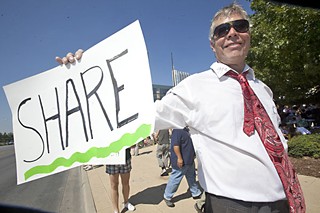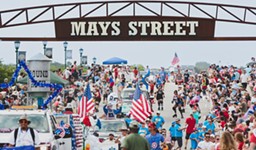Occupying the Future
Participants say they're in it for the long haul
By Ramon Martinez, Fri., Oct. 21, 2011
"Keep Austin Occupied," read a hand-drawn sign along the street at City Hall last Saturday afternoon, Oct. 15, marking the second weekend of Occupy Austin and the launch of Occupy World – the next step in the movement's growing national and international presence. The local solidarity event attracted a crowd of more than 1,000 people, the largest showing since the event's first days. Families, professionals, old folks, and others – distinct from the young, more dressed-down crowd stationed around-the-clock at City Hall – could be seen throughout the march. "It's for her," says a mother pushing a stroller, where her young daughter rides behind a sign reading "Save my future!"
What started on the streets of lower Manhattan on Saturday, Sept. 17, as Occupy Wall Street, a small direct action – initially triggered by a push from anti-consumerist magazine Adbusters – gained global media coverage a week later when a video surfaced of New York Police Department officers pepper-spraying some bystanders and later a mass arrest of marchers under dubious circumstances. The crowd, bolstered by support from larger organizations, grew to a permanent encampment a few blocks from Wall Street. In the days since, the movement has spread nationally and internationally, largely by way of its own social media, to as many as 1,500 cities.
In Austin, readers should undoubtedly recall the 12,000-plus people marching with Save Texas Schools at the Capitol in spring. To put the numbers into context, 10,000 people marched with Occupy Wall Street in NYC last Saturday, one of the largest showings to date. In Austin, throughout the week, at any time there can be 200 people on hand or an early-morning low of a scattered handful, joined intermittently by other groups. At City Hall, a single symbolic tent sits in contrast to the rows of lived-in tents in New York or Boston or Seattle; absent, for the most part, is the sustained visible presence of student groups, environmentalists, or unions reported elsewhere. "We did an initial march in solidarity with the Occupy movement, and I've seen other organizations down there," says Gregorio Casar of the Workers Defense Project. "But we've been working every single day with these issues since even before 2008. Our group just hasn't gotten around to making a collective decision on Occupy Austin."

The movement's still unfocused message – largely "anti-Wall Street" but united in little else – may be partly to blame, but Michelle Millette, one young participant, takes the opposite tack. "It's the refusal of leaders and a political agenda that makes this truly inspiring," she said. "There's no 'vote for this candidate or this ballot measure.' It's what attracts people and sets the Occupy movement apart from everything else out there."
"There's a lot of media attention on fractures and arrests and a lack of organization that's preventing people from coming down," explains Dawnielle Castledine, a member of Occupy Austin's banking committee. She estimates that $75,000 has been removed from local branches of Chase Bank and Bank of America, and she says there's a strong union presence and collaboration with traditional social justice groups. "There are a lot of tired, exhausted people out here working their butts off."
At Occupy Austin you can consistently count on the presence of passion. Conversations at the general assembly, a twice-daily organizational gathering, start late but quickly grow heated, with loud indictments of power grabs during what eventually becomes a three-hour session. Decisions are finally made for this or that committee – except the next day, the decisions often remain unmaterialized or even forgotten until someone finally takes action independently of all the time and energy it took just to come to an agreement.
But the local incarnation of the Occupy movement remains representative in its rabid embrace of new media. Beyond the basic Facebook events and Twitter coverage that this year's Middle East protests popularized, the movement is connected through its separate branches' Web presences and the continuously strong webcasting of Occupy Wall Street's self-reporting, philosophical leanings, and inspirational messaging. A novel Livestream digital video channel lets you tune in live at any moment to almost every Occupy action, including in Austin, where you could have watched live video of four young men getting arrested at 2:40am last Thursday for declining to move for a cleaning crew. You can also now listen online to an Internet radio station inspired by the Austin occupation at www.occupyradioaustin.org.
On the ground at City Hall, the communication style is quite different and quite distinctive. Someone yells, "Mic check!" and the crowd responds, "Mic check!" From a perch just above the crowd on the public amphitheatre, a young man continues, "We're about to begin," and the crowd repeats, "We're about to begin" ... "This morning's march" ... "This morning's march," until an entire statement is communicated in this way. For all that's missing or confused in the organizing, there's an undeniable energy reverberating on the steps of City Hall. Asked if she thought protesters would be here three months from now, Castledine responds, "Yes." Six months? "Yep." A year? "I think so. These are people here who have been affected by the last few years in ways you can't imagine, and they aren't going anywhere until things change."
Got something to say on the subject? Send a letter to the editor.












